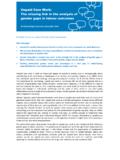Transcription of Sensitivity Analysis in Multiple Imputation for Missing Data
1 Paper SAS270-2014. Sensitivity Analysis in Multiple Imputation for Missing data Yang Yuan, SAS Institute Inc. ABSTRACT. Multiple Imputation , a popular strategy for dealing with Missing values, usually assumes that the data are Missing at random (MAR). That is, for a variable Y, the probability that an observation is Missing depends only on the observed values of other variables, not on the unobserved values of Y. It is important to examine the Sensitivity of inferences to departures from the MAR assumption, because this assumption cannot be verified using the data . The pattern-mixture model approach to Sensitivity Analysis models the distribution of a response as the mixture of a distribution of the observed responses and a distribution of the Missing responses.
2 Missing values can then be imputed under a plausible scenario for which the Missing data are Missing not at random (MNAR). If this scenario leads to a conclusion different from that of inference under MAR, then the MAR. assumption is questionable. This paper reviews the concepts of Multiple Imputation and explains how you can apply the pattern-mixture model approach in the MI procedure by using the MNAR statement, which is new in SAS/STAT You can specify a subset of the observations to derive the Imputation model, which is used for pattern Imputation based on control groups in clinical trials. You can also adjust imputed values by using specified shift and scale parameters for a set of selected observations, which are used for Sensitivity Analysis with a tipping-point approach.
3 INTRODUCTION. Missing values are a problem in many statistical analyses. Most SAS statistical procedures exclude from Analysis observations that have any Missing variable values. These observations are called incomplete cases. Although using only complete cases is simpler, you lose the information that is in the incomplete cases. Excluding observations that have Missing values also ignores the possibility of systematic differences between complete cases and incomplete cases, so the resulting inference might not apply to the entire population, especially when you have a small number of complete cases. One strategy that you can use to handle Missing values is Multiple Imputation , which replaces each Missing value with a set of plausible values that represent the uncertainty about the right value to impute (Rubin 1976, 1987).
4 You then analyze the multiply imputed data sets by using standard procedures for complete data and combining the results from these analyses. Multiple Imputation does not attempt to estimate each Missing value through simulated values, but rather to represent a random sample of the Missing values. This process results in valid statistical inferences that properly reflect the uncertainty that results from Missing values, such as valid confidence intervals for parameters. Multiple Imputation inference involves three distinct phases: 1. The Missing data are filled in m times to generate m complete data sets. 2. The m complete data sets are analyzed by using standard SAS procedures. 3. The results from the m complete data sets are combined for the inference.
5 The MI procedure is a Multiple Imputation procedure that creates multiply imputed data sets for incomplete p-dimensional multivariate data . It uses methods that incorporate appropriate variability across the m imputations. Which Imputation method you choose depends on the patterns of missingness in the data and the type of the imputed variable. 1. A data set that contains the variables Y1 , Y2 , .. , Yp (in that order) is said to have a monotone Missing pattern when the event that a variable Yj is Missing for a particular individual implies that all subsequent variables Yk , k > j , are Missing for that individual. For data sets that have monotone Missing patterns, the variables that contain Missing values can be imputed sequentially using covariates constructed from their corresponding sets of preceding variables.
6 You can use a regression method or a predictive mean matching method to impute Missing values for a continuous variable; a logistic regression method to impute Missing values for a classification variable that has a binary, nominal, or ordinal response; and a discriminant function method to impute Missing values for a classification variable that has a binary or nominal response. For data sets that have arbitrary Missing patterns, you can use either of the following methods to impute Missing values: a Markov chain Monte Carlo (MCMC) method (Schafer 1997) that assumes multivariate normality, or a fully conditional specification (FCS) method (Brand 1999; van Buuren 2007) that assumes the existence of a joint distribution for all variables.
7 An FCS method uses a separate conditional distribution for each imputed variable. The applicable methods are similar to the methods available for data sets that have monotone Missing patterns. After you analyze the m complete data sets by using standard SAS procedures, you can use the MIANALYZE. procedure to generate valid statistical inferences about these parameters by combining results from the m analyses. Multiple Imputation usually assumes that the data are Missing at random (MAR). That is, for a variable Y, the probability that an observation is Missing depends only on the observed values of other variables, not on the unobserved values of Y. The MAR assumption cannot be verified, because the Missing values are not observed.
8 For a study that assumes MAR, the Sensitivity of inferences to departures from the MAR assumption should be examined (National Research Council 2010, p. 111). If it is plausible that the Missing data are not MAR, you can perform Sensitivity Analysis under the Missing not at random (MNAR) assumption. That is, Missing values are imputed under a plausible MNAR scenario, and the results are examined. If this scenario leads to a conclusion different from that of inference under MAR, then the MAR assumption is questionable. The following section describes Sensitivity Analysis for the MAR assumption, followed by two examples: one to specify sets of observations for Imputation models and the other to adjust imputed values for a subset of observations.
9 Sensitivity Analysis FOR THE MAR ASSUMPTION. Multiple Imputation usually assumes that the data are Missing at random (MAR). For example, suppose the data contain a set of fully observed variables X and a variable Y that contains Missing observations. Also suppose R is a response indicator whose element is 0 or 1, depending on whether Y is Missing or observed. Then, the MAR assumption is that the probability that the Y value is Missing for an observation can depend on the observed values of X for the observation, but not on the unobserved value of Y. That is, pr. R j X; Y / D pr. R j X /. It can be shown that pr. Y j X; R / D pr. Y j X /. which implies pr. Y j X; R D 0 / D pr. Y j X; R D 1 /. Thus the posterior distribution of observations that have observed Y, pr.
10 Y j X; R D 1 /, can be used to create imputations for Missing data under the MAR assumption. A straightforward Sensitivity Analysis for the MAR assumption in Multiple Imputation is based on the pattern- mixture model approach (Little 1993; Molenberghs and Kenward 2007, pp. 30, 34 37), which models the distribution of a response as the mixture of a distribution of the observed responses and a distribution of the Missing responses: pr. Y; X; R / D pr. Y; X j R/ pr. R / D pr. Y; X j R D 0/ pr. R D 0 / C pr. Y; X j R D 1/ pr. R D 1 /. 2. Under the MNAR assumption, the probability that the value of Y is Missing for an observation can depend on the unobserved value of Y, pr. R j X; Y / pr. R j X /. which implies pr. Y j X; R D 0 / pr.

















